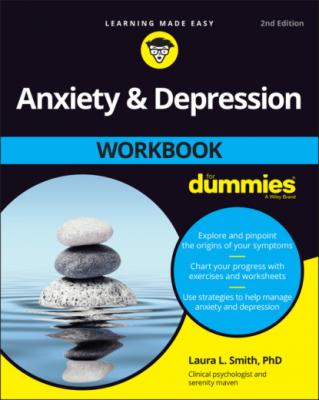Anxiety and Depression Workbook For Dummies. Laura L. Smith
Читать онлайн.| Название | Anxiety and Depression Workbook For Dummies |
|---|---|
| Автор произведения | Laura L. Smith |
| Жанр | Журналы |
| Серия | |
| Издательство | Журналы |
| Год выпуска | 0 |
| isbn | 9781119867449 |
On the other hand, the thoughts of an anxious person might sound like, “I’m going to make a fool out of myself when I give that speech,” “I never know what to say at parties,” “The freeway scares me to death,” “I know that the odds of a plane crash are small, but flying scares me,” or “I’m going to have a nervous breakdown if my editor doesn’t like what I write.”
Thoughts influence the way you feel. The very darkest thoughts usually lead to depression, whereas anxiety usually stems from thoughts about being judged or hurt. And, of course, people often have both types of thoughts.
Although these thoughts can occur to someone who’s depressed or anxious (or both), the odd-numbered items are most indicative of depression, and the even-numbered items reflect anxious thinking. There’s no pass or fail mark on this quiz. However, the more items you endorse, the more you have cause for concern; specifically, if you check more than eight or ten items, you should think seriously about addressing your condition. At the same time, if you very strongly believe in or you frequently have any of these thoughts, you may have too much anxiety or depression. For example, if you worry all the time (item number 2) with no relief, you could benefit from working on that issue.
Worksheet 1-1 The Negative Thinking Quiz
| 1. Things are getting worse and worse for me.2. I worry all the time.3. I think I’m worthless.4. I never know what to say.5. No one would miss me if I were dead.6. I’m afraid that I’ll get sick.7. I think I’m a failure.8. My thoughts race, and I obsess about things.9. I don’t look forward to much of anything.10. I get really nervous around people I don’t know.11. The world would be better off without me.12. Thoughts about past traumas keep rolling through my mind.13. I find it impossible to make decisions.14. I can’t stand it when I’m the center of attention.15. My life is full of regrets.16. I can’t stand making mistakes.17. I don’t see things getting any better in the future.18. I worry about my health all the time.19. I’m deeply ashamed of myself.20. I over-prepare for everything. |
Worksheet 1-2 My Reflections
Blue and Anxious Behavior
If you were to follow a depressed or anxious person around, you might see some behavioral signs of their emotional turmoil. That’s because depression and anxiety on the inside affect what people do on the outside. For example, a depressed person may look tired, move slowly, or withdraw from friends and family; an anxious person may avoid socializing or have a trembling voice.
Worksheet 1-3 The Distraught Behavior Quiz
| 1. I’ve been crying for no clear reason.2. I pace around when I’m worried.3. Sometimes I can’t make myself get out of bed.4. I avoid going into crowded areas.5. I can’t seem to make myself exercise.6. I avoid risks because I’m afraid of failure.7. I don’t do things for fun lately.8. I always stay away from activities that could be dangerous.9. I’ve been missing work lately because I just don’t have the motivation.10. I’m really fidgety.11. I feel like I am walking in quicksand; I can’t get moving.12. I avoid people or places because I feel anxious.13. I don’t care what I look like anymore.14. I spend too much time making sure I look okay.15. I don’t laugh anymore.16. My hands shake when I’m nervous.17. I’ve been letting things go that I need to attend to.18. I feel compelled to repeat actions to keep myself safe. |
Again, there’s no pass or fail on this quiz. The more items you check, the greater the problem. Once again, even-numbered items are most consistent with anxiety, and odd-numbered items largely indicate depression. And, of course, like many people, you may have symptoms of both types of problems.
Worksheet 1-4 My Reflections
Physical Funkiness
Depression and anxiety inevitably produce physical symptoms. In fact, some people primarily suffer from changes in appetite, sleep, energy, or pain while reporting few problematic thoughts or behaviors. These symptoms directly affect your body, but they’re not as easily observed by other people as the behavioral signs covered in the preceding section.
Worksheet 1-5 The Sad, Stressed Sensations Quiz
|
1. I have no appetite.2. My palms sweat all the time.3. I wake up too early each morning and can’t go back to sleep.4. I’ve been experiencing a lot of nausea and diarrhea.5. I’ve been sleeping a lot more
|
